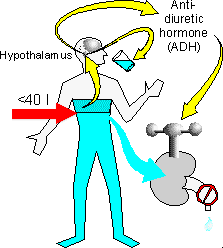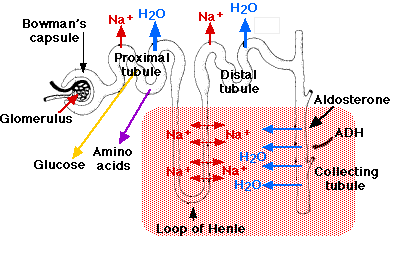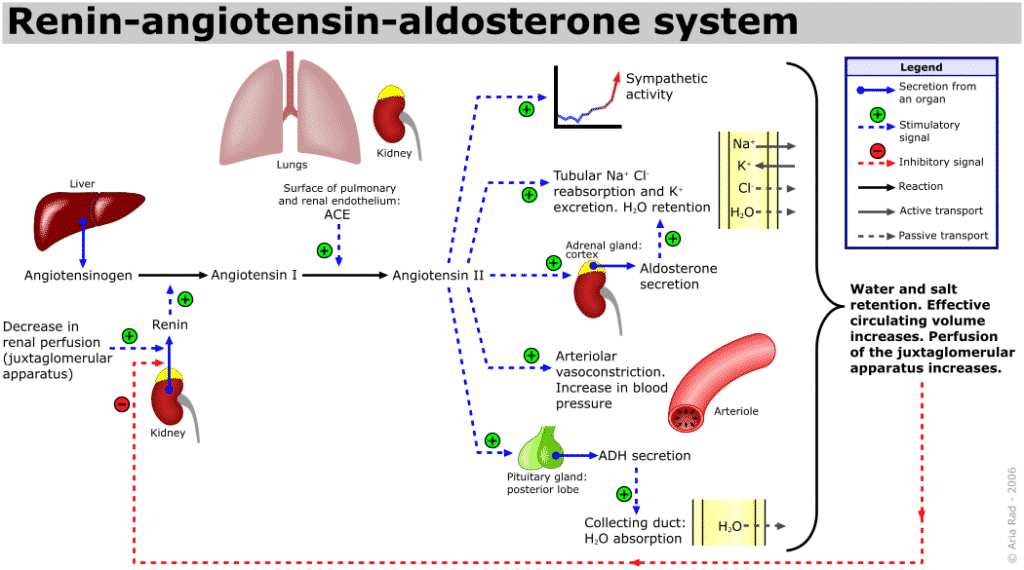The body adjusts to:
- Increased water intake by increasing urine output
- Decreased water intake or increased exercise by decreasing urine output
- To do this your body’s nervous system has to communicate with the endocrine system
- Water balance is regulated by antidiuretic hormone (ADH)
- ADH regulates the osmotic pressure of body fluids by causing the kidneys to increase water reabsorption.
ADH
- The permeability of the distal tubule and collecting duct is controlled by ADH
- ADH is produced in the hypothalamus and is stored and released from the pituitary gland.
- ADH increases the permeability of the distal tubule and collecting duct, so more water is reabsorbed
- This causes the urine to become more concentrated
Response to decrease in body water
- Decrease body water = increase blood solutes = increase blood’s osmotic pressure.
- Osmoreceptors in the hypothalamus cells detect changes in the osmotic pressure in capillaries
- Water from the hypothalamic cells moves into the bloodstream (osmosis), causing these cells to shrink.
- A nerve message is sent to the pituitary to release ADH.
- ADH travels in the blood to the kidneys.
- Kidneys reabsorb more water, producing more concentrated urine.
- Shrinking of the hypothalamic cells also initiates a sensation of thirst.
As water is consumed…
- Decrease blood’s osmotic pressure.
- Blood becomes more dilute, water moves from the blood into the hypothalamus.
- Hypothalamic cells swell and nerve messages to the pituitary gland stop.
- Less ADH released and less water is reabsorbed.
Diuretics
- Alcohol and caffeine are examples of diuretics – drugs that increase the frequency of urination
- These drugs block the release of ADH, thereby increasing the volume of urine
- Excessive use can lead to dehydration
ADH and the Nephron
- 85% of the water filtered into the nephron is reabsorbed in the proximal tubule.
- The proximal tubule is very permeable to water.
With ADH…
Upper part of distal tubule and collecting duct becomes permeable to water.
Without ADH…
The remaining 15% will not be reabsorbed.
- Active transport of Na+ from ascending section of the loop of Henle concentrates solutes in the medulla.
- High [NaCl] in intercellular spaces creates an osmotic pressure that draws water from the upper part of the distal tubule and collecting duct but only when ADH present.
- As water passes into the blood, the filtrate in the nephron becomes more concentrated.
Kidneys and Blood Pressure
Increase fluid loss = decrease blood pressure (BP)
- Kidneys regulate blood pressure by adjusting the volume of blood.
- BP receptors in the juxtaglomerular apparatus detects low BP.
- Causes the release of renin which converts angiotensinogen into angiotensin.
Functions of Angiotensin:
- Constriction of blood vessels.
- Stimulates release of aldosterone.
Aldosterone and Blood Pressure
- Produced in the cortex of the adrenal glands which are located above each kidney.
- Aldosterone acts on the distal tubule and collecting duct to increase Na+ ion reabsorption.
- Cl- is also reabsorbed forming NaCl
- As NaCl reabsorption increases, the osmotic gradient increases and more water moves out of the nephron, thus increasing blood pressure
pH Balance
- Body pH around 7.3 – 7.5.

- If the blood pH fluctuates the secretion of H+ in the nephron either increases or decreases until it returns to normal
- Acid-base balance is also maintained by buffer systems that absorb excess H+ ions or alkaline ions.
Bicarbonate-Carbon Dioxide Buffer System
- Excess H+ buffered by bicarbonate ions.
- Carbonic acid produced and converts to CO2 and water.
- CO2 expelled from the lungs.
- To remove excess H+ ions, the buffer (HCO3-) must be restored…
- Kidneys restore the HCO3- by reversing the reaction.
- CO2 is actively transported from the peritubular capillaries into the cells that line the nephron.
- CO2 combines with water to produce HCO3- and H+ ions.
- HCO3- diffuses back into the blood to restore the buffer.
- The H+ ions combine with phosphate ions or ammonia and are excreted with the filtrate.



